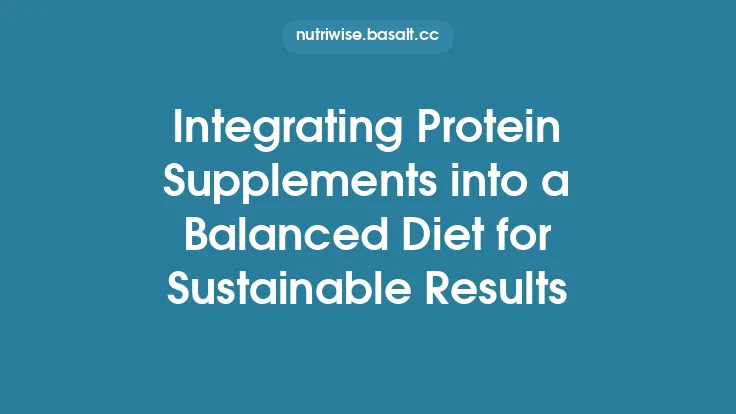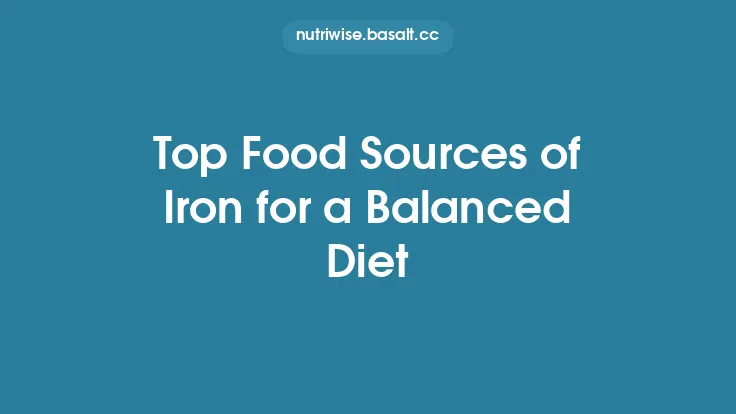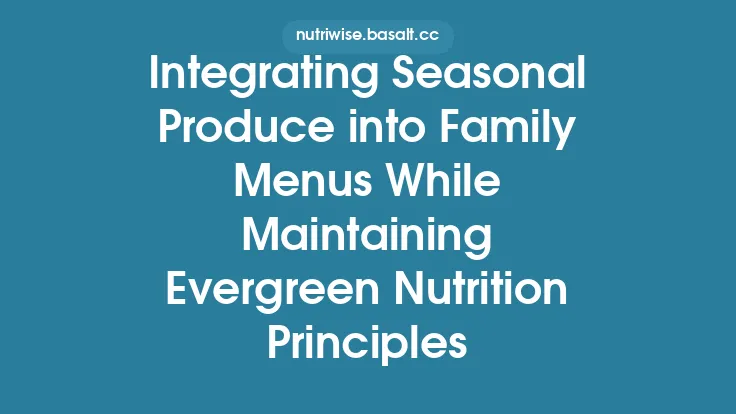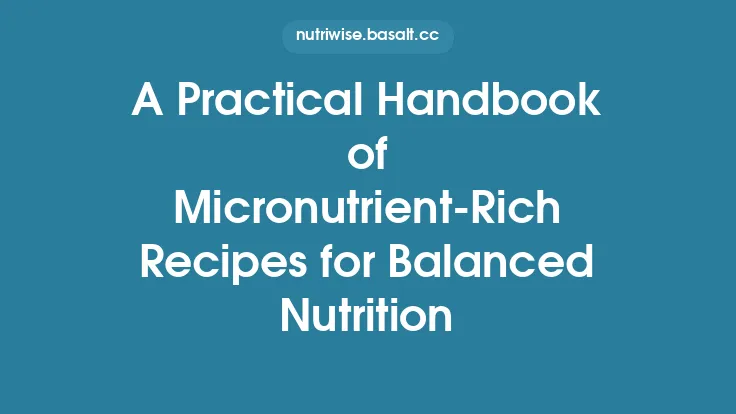Integrating essential minerals into a balanced diet is more than simply ticking off a list of nutrients; it involves thoughtful selection of foods, mindful preparation methods, and strategic planning that aligns with individual health goals, lifestyle patterns, and cultural preferences. While the body’s need for minerals is constant, the ways we meet those needs can vary dramatically across seasons, cuisines, and personal circumstances. This guide offers a comprehensive, evergreen framework for weaving the full spectrum of essential minerals—calcium, phosphorus, potassium, sodium, magnesium, iron, zinc, copper, manganese, selenium, iodine, and chromium—into everyday eating patterns without overlapping the foundational topics covered in adjacent articles.
Assessing Your Mineral Needs
Before constructing a mineral‑rich menu, it is helpful to establish a baseline understanding of personal requirements. The Recommended Dietary Allowances (RDAs) and Adequate Intakes (AIs) provide population‑level benchmarks, but individual needs can diverge based on:
| Factor | Influence on Mineral Needs |
|---|---|
| Age | Growth phases (infancy, adolescence) increase demand for calcium, iron, and zinc; older adults may need more magnesium and potassium to support bone health and blood pressure regulation. |
| Sex | Premenopausal women typically require more iron due to menstrual losses; men often have higher caloric intakes, influencing overall mineral volume. |
| Physical Activity | Endurance athletes lose sodium and potassium through sweat; strength training can elevate magnesium requirements for muscle recovery. |
| Health Conditions | Chronic kidney disease alters phosphorus and potassium handling; gastrointestinal disorders may impair absorption of iron and zinc. |
| Medication Use | Diuretics can increase sodium and potassium excretion; proton‑pump inhibitors may reduce magnesium absorption. |
A practical first step is to complete a brief dietary audit—tracking food intake for 3–7 days—and compare the observed mineral totals against the RDAs using a reliable nutrition analysis tool. This audit highlights gaps and excesses, guiding subsequent food choices.
Choosing Whole Food Sources
Whole foods naturally contain a matrix of minerals that are often more bioavailable than isolated supplements. Below is a curated list of mineral‑dense foods, organized by the primary mineral they contribute, along with typical serving sizes and approximate mineral content:
| Primary Mineral | Food (Serving Size) | Approx. Mineral Content |
|---|---|---|
| Calcium | Low‑fat yogurt (1 cup) | 300 mg |
| Sardines with bones (3 oz) | 325 mg | |
| Collard greens, cooked (½ cup) | 250 mg | |
| Phosphorus | Pumpkin seeds (¼ cup) | 350 mg |
| Chicken breast, roasted (3 oz) | 210 mg | |
| Lentils, cooked (½ cup) | 180 mg | |
| Potassium | Sweet potato, baked (1 medium) | 540 mg |
| Avocado (½ fruit) | 485 mg | |
| White beans, cooked (½ cup) | 600 mg | |
| Sodium | Seaweed snack (1 oz) | 300 mg (natural) |
| Pickled cucumbers (¼ cup) | 400 mg (added) | |
| Magnesium | Almonds (¼ cup) | 100 mg |
| Quinoa, cooked (½ cup) | 60 mg | |
| Spinach, sautéed (½ cup) | 80 mg | |
| Iron | Beef liver, cooked (3 oz) | 5 mg (heme) |
| Lentils, cooked (½ cup) | 3 mg (non‑heme) | |
| Dark chocolate (70% cacao, 1 oz) | 2 mg | |
| Zinc | Oysters, raw (3 oz) | 74 mg |
| Chickpeas, cooked (½ cup) | 1.3 mg | |
| Cashews (¼ cup) | 1.6 mg | |
| Copper | Shiitake mushrooms (½ cup) | 0.5 mg |
| Sunflower seeds (¼ cup) | 0.4 mg | |
| Liver, beef (3 oz) | 4 mg | |
| Manganese | Brown rice, cooked (½ cup) | 0.7 mg |
| Pine nuts (¼ cup) | 1.0 mg | |
| Oats, rolled (½ cup) | 0.5 mg | |
| Selenium | Brazil nuts (1 nut) | 68 µg |
| Tuna, canned in water (3 oz) | 70 µg | |
| Whole wheat bread (2 slices) | 15 µg | |
| Iodine | Seaweed (nori, 1 sheet) | 16 µg |
| Yogurt, plain (1 cup) | 75 µg | |
| Eggs, whole (1 large) | 24 µg | |
| Chromium | Broccoli, steamed (½ cup) | 22 µg |
| Grape juice (½ cup) | 8 µg | |
| Whole grain bread (2 slices) | 12 µg |
Key Takeaway: Prioritize a diverse array of whole foods to capture the full mineral spectrum, while also benefiting from the synergistic compounds (fiber, phytochemicals) that accompany them.
Strategic Meal Composition
A balanced plate that naturally distributes minerals can be built using the “macro‑micronutrient layering” approach:
- Base Layer – Complex Carbohydrates
Choose whole grains (quinoa, farro, brown rice) or starchy vegetables (sweet potatoes, squash). These provide magnesium, phosphorus, and potassium while delivering sustained energy.
- Protein Layer – Animal or Plant
Incorporate lean meats, fish, legumes, or tofu. Animal proteins are rich in heme iron and zinc; legumes contribute non‑heme iron, magnesium, and copper.
- Vegetable Layer – Colorful Variety
Aim for at least two different colors per meal. Dark leafy greens (kale, collard greens) supply calcium and magnesium; orange vegetables (carrots, pumpkin) add potassium; cruciferous veggies (broccoli, Brussels sprouts) contribute calcium, potassium, and trace minerals.
- Healthy Fat Layer – Nuts, Seeds, Avocado
These foods are dense in magnesium, zinc, copper, and selenium, and they aid the absorption of fat‑soluble vitamins that indirectly support mineral metabolism.
- Flavor & Electrolyte Layer – Herbs, Spices, Condiments
Sea salt, soy sauce, miso, and fermented foods can contribute modest sodium and trace minerals while enhancing palatability.
Practical Example – A Day’s Menu
| Meal | Components | Mineral Highlights |
|---|---|---|
| Breakfast | Oatmeal (½ cup) topped with sliced banana, chia seeds (1 tbsp), and a dollop of Greek yogurt | Potassium, magnesium, calcium, zinc |
| Mid‑Morning Snack | Handful of almonds (¼ cup) | Magnesium, copper |
| Lunch | Quinoa salad with black beans (½ cup), roasted sweet potato cubes, kale, avocado, and a lemon‑tahini dressing | Iron, potassium, calcium, magnesium |
| Afternoon Snack | Seaweed crisps (1 oz) and a small orange | Iodine, sodium, vitamin C (enhances iron absorption) |
| Dinner | Grilled salmon (3 oz), sautéed spinach (½ cup), brown rice (½ cup), and a side of steamed broccoli | Selenium, calcium, iron, manganese |
| Evening | Warm milk (1 cup) with a pinch of cinnamon | Calcium, magnesium |
Cooking Techniques that Preserve Mineral Content
Minerals are generally stable under heat, but certain cooking practices can cause leaching into cooking water or loss through evaporation. Below are evidence‑based methods to maximize retention:
| Technique | How It Helps | Practical Tips |
|---|---|---|
| Steaming | Minimal water contact reduces leaching of water‑soluble minerals (e.g., potassium) | Steam vegetables for 5–7 minutes; avoid over‑cooking to preserve texture and nutrients. |
| Stir‑Frying | Quick, high‑heat cooking with a small amount of oil retains minerals while enhancing bioavailability of fat‑soluble compounds that aid mineral utilization | Use a wok; add mineral‑rich ingredients (e.g., tofu, shrimp) early for even heat distribution. |
| Roasting/Baking | Concentrates flavors without water loss; minerals remain within the food matrix | Roast root vegetables at 400 °F for 30–40 minutes, turning halfway. |
| Pressure Cooking | Shortens cooking time, limiting mineral leaching; the cooking liquid can be repurposed as a broth | Cook beans or whole grains under pressure; retain the liquid for soups or sauces. |
| Blanching Followed by Quick Cooling | Preserves color and texture while limiting mineral loss; the brief exposure to water is offset by immediate cooling | Blanch green beans for 2 minutes, then shock in ice water; use the blanching water as a base for vegetable stock. |
Avoid prolonged boiling of vegetables in excess water, as this can cause up to 30 % loss of potassium and magnesium. If boiling is necessary (e.g., for potatoes), reserve the cooking water for mashed dishes or soups to reclaim the leached minerals.
Combining Foods for Enhanced Mineral Utilization
While the article does not delve deeply into absorption mechanisms, it is useful to note practical food pairings that naturally improve mineral uptake:
- Vitamin C + Non‑heme Iron: Pair beans or lentils with citrus, bell peppers, or tomatoes to boost iron absorption.
- Vitamin D + Calcium: Include fatty fish (salmon, mackerel) or fortified dairy alongside calcium‑rich greens for synergistic bone health.
- Healthy Fats + Fat‑Soluble Vitamins: Add avocado or olive oil to salads containing kale or spinach, facilitating the absorption of vitamin K, which indirectly supports calcium metabolism.
- Probiotic‑Rich Foods + Minerals: Fermented foods (kimchi, sauerkraut) can improve gut health, creating a favorable environment for mineral absorption without needing to discuss the underlying physiology.
These pairings are simple, culturally adaptable, and reinforce the principle of “food synergy” without repeating content from the neighboring articles.
Seasonal and Cultural Food Choices
Integrating minerals does not require exotic ingredients; leveraging seasonal produce and traditional cuisines can naturally meet mineral goals.
| Season | Mineral‑Rich Options | Cultural Inspiration |
|---|---|---|
| Spring | Asparagus, peas, rhubarb, fresh herbs | Mediterranean: herb‑infused grilled fish with quinoa |
| Summer | Watermelon, tomatoes, corn, berries | Mexican: black bean and corn tacos with avocado |
| Autumn | Pumpkin, kale, apples, walnuts | Middle Eastern: lentil stew with spinach and tahini |
| Winter | Root vegetables, citrus, fortified cereals, sardines | Nordic: rye bread with smoked salmon and fermented cabbage |
By aligning meal planning with seasonal availability, you not only enhance flavor and variety but also reduce reliance on processed foods that may contain excessive sodium or lack mineral density.
Supplementation: When and How to Use
Whole foods should remain the primary source of minerals, yet certain life stages or health conditions may warrant targeted supplementation:
- Pregnancy & Lactation: Iron and iodine needs increase; a prenatal multivitamin containing these minerals can bridge dietary gaps.
- Older Adults: Vitamin D and calcium supplements may be recommended to support bone health, especially when dairy intake is limited.
- Athletes in Hot Climates: Electrolyte powders containing sodium, potassium, and magnesium can help replace sweat losses during prolonged endurance events.
- Vegetarians/Vegans: Vitamin B12 is not a mineral but often co‑formulated with zinc, iron, and iodine in fortified products; consider a B12‑plus mineral supplement if dietary intake is insufficient.
Best Practices for Supplement Use
- Choose Reputable Brands – Look for third‑party testing (USP, NSF) to ensure purity.
- Take with Food – Most minerals are better tolerated and absorbed when consumed with meals.
- Avoid Overlap – Track total intake from food and supplements to prevent exceeding upper intake levels, particularly for sodium, iron, and selenium.
- Periodic Review – Reassess the need for supplements annually or after major health changes.
Special Considerations for Different Life Stages
| Life Stage | Key Mineral Focus | Practical Strategies |
|---|---|---|
| Infancy (0‑12 mo) | Iron, zinc, calcium | Breast milk or iron‑fortified formula; introduce pureed meats and legumes after 6 months. |
| Childhood (1‑12 yr) | Calcium, magnesium, iodine | Milk, yogurt, cheese; incorporate seaweed snacks or iodized salt in modest amounts. |
| Adolescence | Iron (girls), calcium, potassium | Lean red meat, fortified cereals, leafy greens; encourage sports drinks with balanced electrolytes only during intense activity. |
| Reproductive Age (Women) | Iron, iodine, selenium | Emphasize lean red meat, seafood, nuts; use iodized salt in cooking. |
| Men (30‑60 yr) | Magnesium, zinc, selenium | Whole grains, nuts, seeds, lean poultry; limit processed meats. |
| Older Adults (60+ yr) | Calcium, vitamin D, potassium | Low‑fat dairy, fortified plant milks, bananas, beans; monitor sodium intake to support blood pressure. |
Tailoring meals to these stages ensures that mineral intake aligns with physiological demands without unnecessary excess.
Monitoring Intake and Adjusting the Plan
A dynamic approach to mineral integration involves regular self‑assessment and, when appropriate, professional guidance.
- Food Diary Review – Every 4–6 weeks, revisit your tracked meals and compare mineral totals to RDAs.
- Biomarker Checks – Simple blood tests (e.g., ferritin for iron, serum calcium, magnesium) can confirm adequacy, especially for at‑risk groups.
- Symptom Awareness – Fatigue, muscle cramps, or changes in hair/skin may signal imbalances; consult a healthcare provider if persistent.
- Iterative Meal Tweaking – If potassium is low, add a banana or a serving of beans; if sodium is high, replace processed sauces with herbs and spices.
By treating mineral intake as a modifiable variable rather than a static checklist, you maintain flexibility and responsiveness to changing health needs.
Practical Tools and Resources
- Nutrition Analysis Apps – MyFitnessPal, Cronometer, or the USDA FoodData Central API allow quick mineral breakdowns of meals.
- Meal‑Planning Templates – Printable weekly grids that allocate a “mineral focus” for each day (e.g., “Calcium Monday,” “Iron Thursday”).
- Cooking Guides – PDFs on “Mineral‑Preserving Cooking Techniques” that include step‑by‑step photos.
- Community Resources – Local farmers’ markets, community-supported agriculture (CSA) programs, and cultural cooking classes can expand access to diverse mineral‑rich foods.
- Professional Support – Registered dietitians can provide personalized mineral assessments and create tailored meal plans.
Leveraging these tools simplifies the integration process and helps sustain long‑term adherence.
In Summary
Integrating essential minerals into a balanced diet is a multifaceted endeavor that blends nutritional science with practical everyday choices. By assessing individual needs, selecting a wide array of whole‑food sources, employing cooking methods that safeguard mineral content, and thoughtfully pairing foods, you can construct meals that naturally fulfill the body’s mineral requirements. Seasonal and cultural considerations add variety and enjoyment, while targeted supplementation and regular monitoring ensure that specific gaps are addressed safely. With the strategies outlined above, anyone—from busy professionals to home cooks—can confidently build a mineral‑rich eating pattern that supports lifelong health and vitality.





